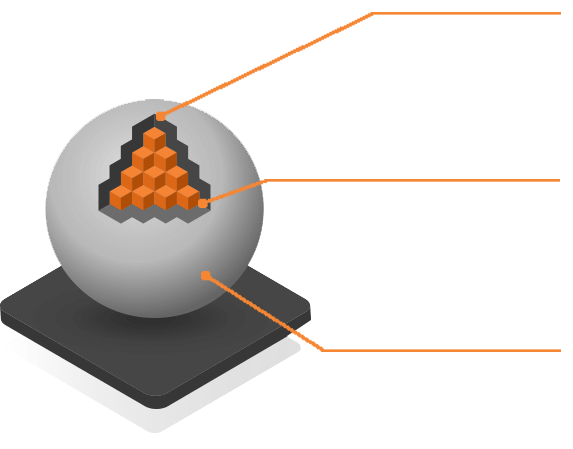An approach that aligns with the industry need for effective digital transformation delivered at the speed of business.

How does
it work?

Automation
This layer addresses the speed of converting data to information and then to knowledge, with limited human intervention.
Optimization
The core layer which is responsible for keeping the system alive and relevant by constantly monitoring and providing feedback by gaining insights from your data.
Orchestration
The seamless interaction between processes across applications forms the fabric of this layer, governed by rules driven by your internal polcies.

Orchestrate
Orchestration forms the fundamental fabric that holds all the different processes together. We call this layer the rule book by which the process ecosystem must abide. While digital transformation initiatives may run successfully in silos, the amalgamation of these initiatives with other business and physical processes is what will truly bring outcomes.
The idea is to provide a seamless experience, much like a symphony orchestra, quickly and efficiently.
How do we achieve this?
Step 1
Synchrony
While we pride ourselves on the ease of integration with any application in your entire digital ecosystem, we also spend a fair amount of time analyzing each policy and the most effective way to incorporate the same into your digital ecosystem. This may involve re-visiting the way you currently execute your business processes, or it could involve adding a new process altogether.
Step 2
Harmony
No one enjoys a cacophony, but everyone loves a beautifully coordinated orchestra. After incorporating the business policies, the next focus is to ensure that all the systems interact with each other such that all evidence of this uber-complex interaction remains under the hood while the users rev up the systems and race away to their goal.
Step 3
Symbiosis
The prerequisite for a system to stay lean and efficient is to remove all redundancy. Our team spends time in understanding the rest of your digital ecosystem in order to ensure that there is a logical and healthy exchange of data among all the active information systems for the processes in question.
AUTOMATE
Automation is grouped as the next layer of our offering, and it focuses on designing robust yet flexible solutions that make mission-critical tasks work on their own to transform data into decisions, within the orchestration framework. At Elde, we understand the importance of technology; moreover, we recognize that successful automation is the effective amalgamation of business policies, physical check-points, and digital platforms. As we leverage a combination of hardware and software technologies, we have identified and categorized this process into various levels: physical process automation, business process automation, and digital process automation.
How do we achieve this?
Step 1
Digital Processes
Digital process automation focuses on seamlessly attaching our solution/platform to your existing infrastructure such that it enhances the user experience by allowing complete access to your shop floor anytime, anywhere. Moreover, our solutions are designed such that for mission-critical policy violations, the system will proactively reach out to the stakeholders with a call to action.
Step 2
Physical Processes
Automating physical processes essentially involves using embedded systems that adopt technologies such as RFID (radio frequency identification) for wireless communication, GPS (global positioning systems) for location tracking, 2G to 4G data communication technology for various applications, OPC & MODBUS protocols for integration with control systems such as PLC/SCADA, OCR (optic character recognition) technology for data acquisition, and much more.
Step 3
Business Processes
Business processes are covered by us via detailed workshops wherein business analysts will understand your processes, discuss key pain areas, suggest improvements, and, finally, list down all business policies. At what level these policies are to be executed will help us arrive at the level at which automation is required.
Optimize
The Optimization engine is the active ingredient in our solutions. The objective of this stratum is to constantly focus on monitoring the current data and looking towards potential change, which is why we place it at the core of our solutions. This essentially implies that there is always a need to build a feedback loop and implement a continuous improvement process. We achieve this by ensuring a mix of three key factors: keeping the feedback system intelligent, proactive, and prescriptive.
How do we achieve this?
Step 1
Intelligent
Building intelligence into the feedback system essentially involves a continuous referencing of information with the business policy or the defined norm. To this effect, our team may dive deep into utilizing your performance indicators as a ready reference to log policy violations and suggest potential improvements.
Step 2
Proactive
We do not believe in lengthy and complicated reporting; hence, we work towards building a system such that all the complicated reporting is analyzed internally, and if there is something that requires your attention, the system will proactively alert the relevant stakeholders.
Step 3
Prescriptive
With the advantage of large amounts of data being stored, we strive to build a prescriptive system such that the diagnosis and analysis are managed intelligently by the optimization engine, with only an outcome prescribing the best way forward to the most favorable outcome.






